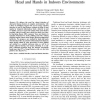Free Online Productivity Tools
i2Speak
i2Symbol
i2OCR
iTex2Img
iWeb2Print
iWeb2Shot
i2Type
iPdf2Split
iPdf2Merge
i2Bopomofo
i2Arabic
i2Style
i2Image
i2PDF
iLatex2Rtf
Sci2ools
JMM2
2006
2006
Robust Real-time 3D Detection of Obstructed Head and Hands in Indoors Environments
We address the need for robust detection of obstructed human features in complex environments, with a focus on intelligent surgical UIs. In our setup, real-time detection is used to find features without the help of local (spatial or temporal) information. Such a detector is used to validate, correct or reject the output of the visual feature tracking, which is locally more robust, but drifts over time. In Operating Rooms (OR), surgeons' faces and hands are typically obstructed by sterile clothing and tools, making statistical and/or feature-based feature detection approaches ineffective. We propose a new method for head and hands detection that relies on geometric information from disparity maps, locally refined by color processing. We have applied our method to a surgical mock-up scene, as well as to images gathered during real surgery. Running in a realtime, continuous detection loop, our detector successfully found more than 97% of target features, with very few false positive...
| Added | 13 Dec 2010 |
| Updated | 13 Dec 2010 |
| Type | Journal |
| Year | 2006 |
| Where | JMM2 |
| Authors | Sébastien Grange, Charles Baur |
Comments (0)

